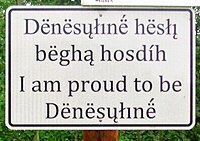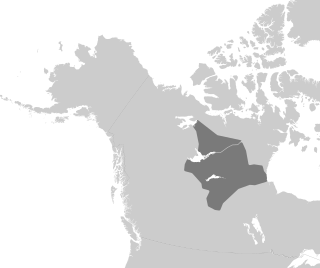
Back Idioma dene suliné AST Chipewyan (Sproch) BAR Dene Suline (sprog) Danish Chipewyan (Sprache) German Ĉipevajana lingvo EO Idioma dené suliné Spanish Chipewyan Finnish Chipewyan (langue) French Denesuline spriak FRR Lingua chipewyan GL
| Chipewyan | |
|---|---|
| Dënesųłinë́ | |
| ᑌᓀ ᓱᒼᕄᓀ ᔭᕠᐁ (Dënesųłinë́ yatié) | |
 Dënesųłinë́ sign at La Loche Airport | |
| Pronunciation | [tènɛ̀sũ̀ɬìné jàtʰìɛ́] |
| Native to | Canada |
| Region | Northern Alberta, Saskatchewan, Manitoba; southern Northwest Territories and Nunavut |
| Ethnicity | 30,910 Chipewyan people (2016 census)[1] |
Native speakers | 11,325, 41% of ethnic population (2016 census)[2] |
| Dialects |
|
| Official status | |
Official language in | Canada (Northwest Territories)[3] |
| Language codes | |
| ISO 639-2 | chp |
| ISO 639-3 | chp |
| Glottolog | chip1261 |
| ELP | Dënesųłiné |
 | |
| People | Dënesųłinë́ |
|---|---|
| Language | Dënesųłinë́ yatıé |
| Country | Dënesųłinë́ nëné, Denendeh ᑌᓀᐣᑌᐧ |
Chipewyan /ˌtʃɪpəˈwaɪən/[4] or Dënesųłinë́ (ethnonym: Dënesųłinë́ yatié[5][6] IPA: [tènɛ̀sũ̀ɬìné jàtʰìɛ́]), often simply called Dëne, is the language spoken by the Chipewyan people of northwestern Canada. It is categorized as part of the Northern Athabaskan language family. It has nearly 12,000 speakers in Canada, mostly in Saskatchewan, Alberta, Manitoba and the Northwest Territories.[7] It has official status only in the Northwest Territories, alongside eight other aboriginal languages: Cree, Tlicho, Gwich'in, Inuktitut, Inuinnaqtun, Inuvialuktun, North Slavey and South Slavey.[3][8]
Most Chipewyan people now use Dëne and Dënesųłinë́ to refer to themselves as a people and to their language, respectively. The Saskatchewan communities of Fond-du-Lac,[9] Black Lake,[10] Wollaston Lake[11] and La Loche are among these.
- ^ Canada, Government of Canada, Statistics (25 October 2017). "Aboriginal Ancestry Responses (73), Single and Multiple Aboriginal Responses (4), Residence on or off reserve (3), Residence inside or outside Inuit Nunangat (7), Age (8A) and Sex (3) for the Population in Private Households of Canada, Provinces and Territories, 2016 Census – 25% Sample Data". www12.statcan.gc.ca. Retrieved 2017-11-22.
{{cite web}}: CS1 maint: multiple names: authors list (link) - ^ "Language Highlight Tables, 2016 Census - Aboriginal mother tongue, Aboriginal language spoken most often at home and Other Aboriginal language(s) spoken regularly at home for the population excluding institutional residents of Canada, provinces and territories, 2016 Census – 100% Data". www12.statcan.gc.ca. Government of Canada, Statistics. 2 August 2017. Retrieved 2017-11-22.
- ^ a b "Official Languages of the Northwest Territories" (PDF). Northwest Territories – Education, Culture and Employment. Archived from the original (PDF) on 2013-12-06. Retrieved 2015-10-18. (map)
- ^ Laurie Bauer, 2007, The Linguistics Student's Handbook, Edinburgh
- ^ "Official Languages of the Northwest Territories". Prince of Wales Northern Heritage Centre. Retrieved 28 April 2020.
- ^ "Languages Overview". Office of the Northwest Territories Official Languages Commissioner. Retrieved 28 April 2020.
- ^ Statistics Canada: 2006 Census Archived October 16, 2013, at the Wayback Machine Sum of 'Chipewyan' and 'Dene'.
- ^ Northwest Territories Official Languages Act, 1988 Archived March 24, 2009, at the Wayback Machine (as amended 1988, 1991–1992, 2003)
- ^ "Prince Albert Grand Council (Fond-du-Lac)". Archived from the original on 2012-02-12. Retrieved 2013-05-26.
- ^ "Prince Albert Grand Council (Black Lake)". Archived from the original on 2014-04-08. Retrieved 2013-05-26.
- ^ "Prince Albert Grand Council (Wollaston Lake)". Archived from the original on 2012-02-12. Retrieved 2013-05-26.